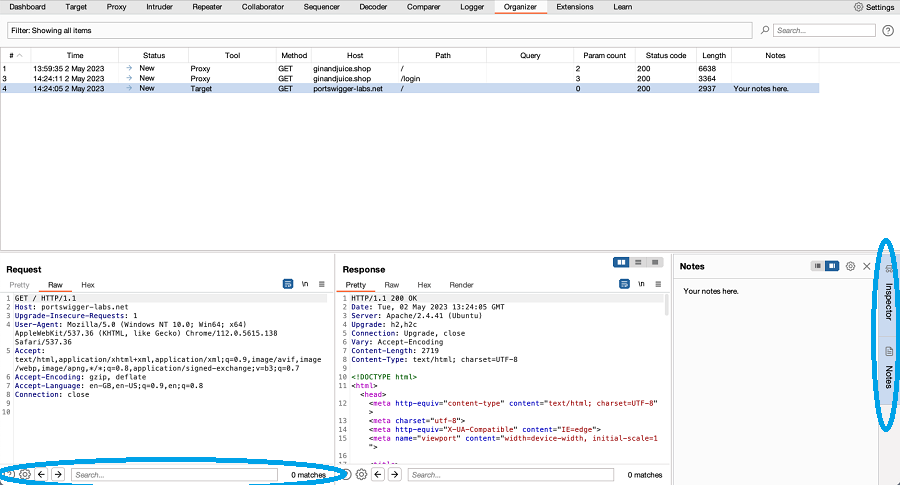ProfessionalCommunity Edition
Burp Organizer
-
Last updated: January 16, 2026
-
Read time: 3 Minutes
Burp Organizer is a tool that enables you to store and annotate copies of HTTP messages that you want to come back to later. Use Burp Organizer to better organize your penetration testing workflow, for example to:
- Store messages that you want to investigate later.
- Save messages that you've already identified as interesting.
- Save messages that you want to add to a report later.
Sending messages to Organizer
You can send HTTP messages to Burp Organizer from other Burp tools. Right-click the message and select Send to Organizer, or use the default hotkey Ctrl + O. Each message that you sent to Organizer is a read-only copy of the original message, saved at the point you sent it to Organizer. If you added notes in another Burp tool, these are copied across into Organizer.
Once you've sent a message to Organizer, you can edit any notes and update the status of the message. You can also send the message to other Burp tools for further investigation.
Related pages
Organizer table
Messages are stored in a table, which contains the following columns:
- # - The request index number.
- Time - The time the request was made.
- Status - The workflow status that you have applied to the message, for example Done or Paused.
- Tool - The Burp tool that the message was sent from, such as Burp Repeater or Burp Intruder. If the message is sent from Burp Logger or from an item that is already in Organizer, then the tool identified here is the tool that originally generated the HTTP request.
- Method - The HTTP method.
- Host - The server hostname.
- Path - The URL file path.
- Query - The URL query string.
- Param count - The number of parameters in the request.
- Status code - The HTTP status code of the response.
- Length - The length of the response in bytes.
- Notes - Any notes that you have made.
You can customize and sort the table, and copy column data to your clipboard. For more information, see Customizing Burp's tables.
Right-click any item in the table to view the context menu. This enables you to perform actions that can drive your testing workflow. For example, you can send an item to another Burp tool.
You can search in the table and choose which messages are shown in the table. For more information, see Filtering Burp Organizer.
Exporting results
You can export Organizer items as a CSV file to easily share with others or include in your reports.
To export all items:
-
Right-click the table then select Export as CSV.
-
If necessary, choose a directory.
-
Enter a filename and click Save.
To export specific items:
-
Select the items that you want to export.
-
Right-click and select Export as CSV.
-
If necessary, choose a directory.
-
Enter a filename and click Save.
When exporting items in CSV format, Burp represents data as follows:
-
Date times are formatted as:
yyyy-MMM-dd HH:mm:ss.SSS. -
DNS queries and HTTP interactions (including requests and responses) are represented as Base64 encoded strings.
- Any data that contains a comma is escaped by wrapping the data in double quotes. For example, a,b will become "a,b".
- Any data containing double quotes is escaped by an additional double quote. For example, "a" will become """a""".
- Any data starting with -, +, = or @ is escaped for Excel by prefixing a single quote (').
You can also export and import Organizer items as part of a project file. For more information, see Project files.
Viewing HTTP messages
To view the request and response, click on any Organizer item. The request and response are both read-only.
To search within the request or response, select the message, then use the search bar below the message. For more information, see Text editor - Quick search.
You can choose to view either the Inspector panel or Notes panel beside the request and response. To toggle between these, click on the tabs.

Sharing messages in collections
You can create a Burp link for a collection from selected items in Organizer. A collection contains the full contents of any messages you include, and the Burp link lets other Burp Suite Professional users import those messages into their own Organizer, where they can work with them like any other message.
To create a collection, right-click one or more selected items in Organizer, and select Create Burp link for this collection.
For more information, see Collections.


